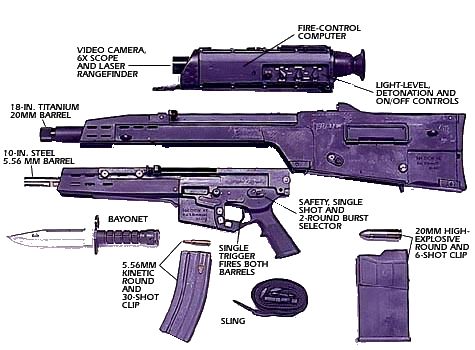
In the Sci fi film Runaway there was a interesting pice of tech that caught my eye, I thought the heat seeking bullet would be a technology thats virtually impossible to exists. Infrared homing refers to a passive missile guidance system which uses the emission from a target of electromagnetic radiation in the infrared part of the spectrum to track and follow it. Missiles which use infrared seeking are often referred to as "heat-seekers", since infrared (IR) is just below the visible spectrum of light in frequency and is radiated strongly by hot bodies. Many objects such as people, vehicle engines and aircraft generate and retain heat, and as such, are especially visible in the infra-red wavelengths of light compared to objects in the background. Normally a pilot or operator recognizes the target, there is a radar lock and once the missile has been fired. Its speeds up to mach 5 eventually to intercept and destroy the target.
What came close to the films smart bullet technology was a gun called the XM25 CDTE, it fired 25mm grenades that are set to explode in mid air or near the target. A laser range finder in the weapon is used to determine the distance to the target.
The user can manually adjust the detonating distance by up to 10 feet (3.0 m) shorter or longer; the XM25 automatically transmits the detonating distance to the grenade in the firing chamber. The grenade tracks the distance it has traveled by the number of spiral rotations after it is fired, then detonates at the proper distance to produce an air burst effect. These features make the XM25 more effective than traditional grenade launchers at the task of hitting targets that are behind cover or dug into the ground One of the weapon's developers, Richard Audette, believes that the XM25 is a big leap forward because it is the first small arms weapon to use smart technology.
Five of the weapons were deployed with the 101st Airborne Division in Afghanistan in October 2010, along with 1,000 hand-made air-burst rounds. The soldiers reported that the weapon was extremely effective at killing or neutralizing enemy combatants firing on US troops from covered positions. The US troops have nicknamed the weapon, "The Punisher." First contact was 3 December 2010. As of February 2011, the weapon has been fired 55 times at a cost of $1,000 each, but the cost is expected to be $35 per shot when in full production, scheduled from 2012. The US Army ordered 36 more of the rifles in January 2012.
The "smart gun" was a concept gun that aims to reduce the misuse of guns, one main idea is to use finger print technology or RFID to lock the guns use to the main owner. This would prevent unlawful gun use and misfiring accidents from minors. There could be two methods of preventing a bullet from firing, one is to use a blocking pin activated by a motor to prevent a mechanical trigger from hitting the bullet. Or another method used by Smith and Wesson , which is to remove all mechanical parts and fire the bullet electronically. In the prevention of unlawful use a Wide Area Control protocol could prevent these smart guns from killing innocent lives via transmitted frequency in public areas.
Metal Storm uses the concept of superposed load; multiple projectiles loaded nose to tail in a single gun barrel with propellant packed between them. The Roman candle, a traditional firework design, employs the same basic concept, however, the propellant continues to burn in the Roman candle's barrel, igniting the charge behind the subsequent projectile. The process is repeated by each charge in turn, ensuring that all projectiles in the barrel are discharged sequentially from the single ignition. Various methods of separately firing each propellant package behind stacked projectiles have been proposed which would allow a "single shot" capability more suitable to firearms.
Engineering researchers at Sandia National Laboratories have developed a new "self guided" bullet capable of steering itself -- like a tiny, silent guided missile -- towards its target. The task of creating the new "smart" bullet was a daunting one, and has occupied the researchers for three years now. The inspiration for the project came from the stalled state of firearms development for the U.S. armed forces.
The resulting 4-inch long, half-an-inch in diameter 0.50 caliber round takes the input of its microoptical sensor and feeds it into an 8-bit CPU, housed inside the shell. The CPU runs correction algorithms and outputs corrections 30 times a second, in the form of signals to electromagnetic actuators attached to small fins on the bullet.
It has a range of 2 km with an accuracy of 8 inches and works on the principle of a laser painted target with the electronics at the front to steer and correct its trajectory from wind change or if the target moves slightly.
Considering that there two companies Sandia National labs and DARPA who are conducting tests quietly, the early results from Sandia have been successful with the .50 cal bullet reaching at speeds of March 2.1. While DARPA will publish their results late in september.
It seems that gun technology is catching up with science fiction and self guiding bullets along with rapid fire and incendiary bullets and high explosives. In the fictional comic of Judge Dredd these type of bullets were part of the tools for the future of law enforcement. The only smart bullet thats missing was the ricochet function which bounced off the walls as a way of circumventing the corners. Its hard to predict if these gun technologies will pass on to civilian hands. I would hope that "Smart gun" might be the answer to Americas gun problem.




No comments:
Post a Comment